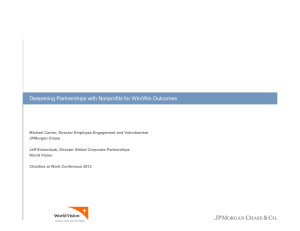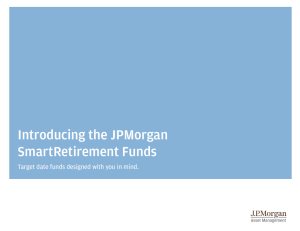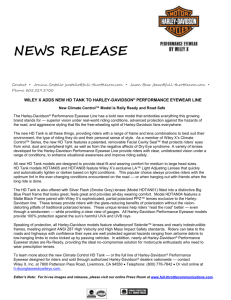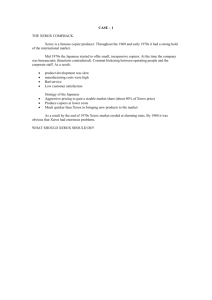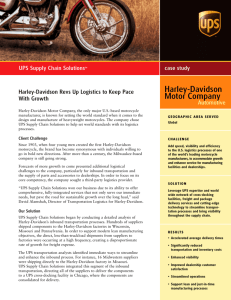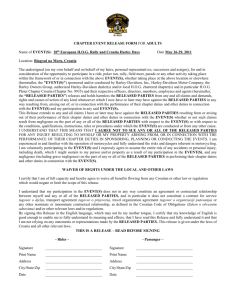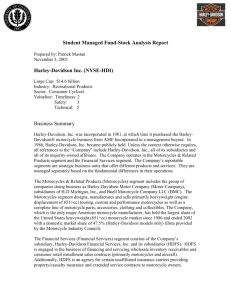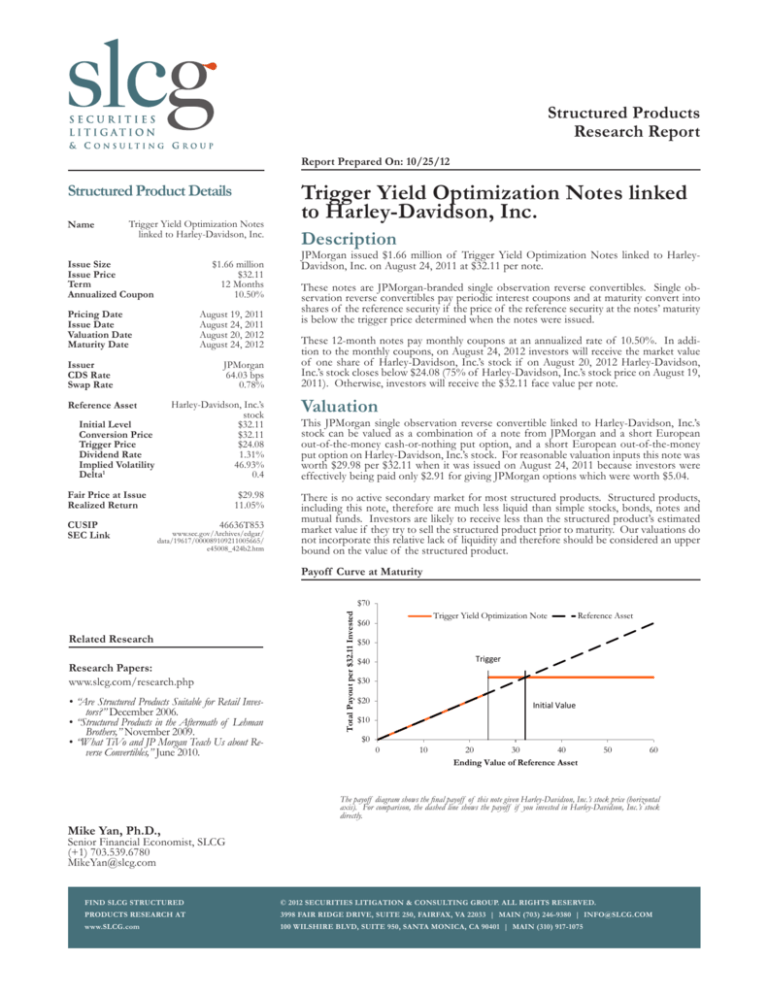
Structured Products
Research Report
Report Prepared On: 10/25/12
Structured Product Details
Name
Trigger Yield Optimization Notes
linked to Harley-Davidson, Inc.
Issue Size
Issue Price
Term
Annualized Coupon
$1.66 million
$32.11
12 Months
10.50%
Pricing Date
Issue Date
Valuation Date
Maturity Date
August 19, 2011
August 24, 2011
August 20, 2012
August 24, 2012
Issuer
CDS Rate
Swap Rate
JPMorgan
64.03 bps
0.78%
Harley-Davidson, Inc.’s
stock
$32.11
$32.11
$24.08
1.31%
46.93%
0.4
Reference Asset
Initial Level
Conversion Price
Trigger Price
Dividend Rate
Implied Volatility
Delta1
Fair Price at Issue
Realized Return
CUSIP
SEC Link
$29.98
11.05%
46636T853
www.sec.gov/Archives/edgar/
data/19617/000089109211005665/
e45008_424b2.htm
Trigger Yield Optimization Notes linked
to Harley-Davidson, Inc.
Description
JPMorgan issued $1.66 million of Trigger Yield Optimization Notes linked to HarleyDavidson, Inc. on August 24, 2011 at $32.11 per note.
These notes are JPMorgan-branded single observation reverse convertibles. Single observation reverse convertibles pay periodic interest coupons and at maturity convert into
shares of the reference security if the price of the reference security at the notes’ maturity
is below the trigger price determined when the notes were issued.
These 12-month notes pay monthly coupons at an annualized rate of 10.50%. In addition to the monthly coupons, on August 24, 2012 investors will receive the market value
of one share of Harley-Davidson, Inc.’s stock if on August 20, 2012 Harley-Davidson,
Inc.’s stock closes below $24.08 (75% of Harley-Davidson, Inc.’s stock price on August 19,
2011). Otherwise, investors will receive the $32.11 face value per note.
Valuation
This JPMorgan single observation reverse convertible linked to Harley-Davidson, Inc.’s
stock can be valued as a combination of a note from JPMorgan and a short European
out-of-the-money cash-or-nothing put option, and a short European out-of-the-money
put option on Harley-Davidson, Inc.’s stock. For reasonable valuation inputs this note was
worth $29.98 per $32.11 when it was issued on August 24, 2011 because investors were
effectively being paid only $2.91 for giving JPMorgan options which were worth $5.04.
There is no active secondary market for most structured products. Structured products,
including this note, therefore are much less liquid than simple stocks, bonds, notes and
mutual funds. Investors are likely to receive less than the structured product’s estimated
market value if they try to sell the structured product prior to maturity. Our valuations do
not incorporate this relative lack of liquidity and therefore should be considered an upper
bound on the value of the structured product.
Payoff Curve at Maturity
Related Research
Research Papers:
www.slcg.com/research.php
•“Are Structured Products Suitable for Retail Investors?” December 2006.
•“Structured Products in the Aftermath of Lehman
Brothers,” November 2009.
•“What TiVo and JP Morgan Teach Us about Reverse Convertibles,” June 2010.
Total Payout per $32.11 Invested
$70
Trigger Yield Optimization Note
$60
Reference Asset
$50
Trigger
$40
$30
$20
Initial Value
$10
$0
0
10
20
30
40
Ending Value of Reference Asset
50
60
The payoff diagram shows the final payoff of this note given Harley-Davidson, Inc.’s stock price (horizontal
axis). For comparison, the dashed line shows the payoff if you invested in Harley-Davidson, Inc.’s stock
directly.
Mike Yan, Ph.D.,
Senior Financial Economist, SLCG
(+1) 703.539.6780
MikeYan@slcg.com
FIND SLCG STRUCTURED
© 2012 SECURITIES LITIGATION & CONSULTING GROUP. ALL RIGHTS RESERVED.
PRODUCTS RESEARCH AT
3998 FAIR RIDGE DRIVE, SUITE 250, FAIRFAX, VA 22033 | MAIN (703) 246-9380 | INFO@SLCG.COM
www.SLCG.com
100 WILSHIRE BLVD, SUITE 950, SANTA MONICA, CA 90401 | MAIN (310) 917-1075
Trigger Yield Optimization Notes linked to Harley-Davidson, Inc.
Page 2
Maturity Payoff Diagram
Principal Payback Table
Harley-Davidson,
Inc.’s Stock
Note Payoff
$0.00
$0.00
$3.21
$3.21
$6.42
$6.42
$9.63
$9.63
$12.84
$12.84
$16.06
$16.06
$19.27
$19.27
$22.48
$22.48
$25.69
$32.11
$28.90
$32.11
$32.11
$32.11
$35.32
$32.11
$38.53
$32.11
$41.74
$32.11
$44.95
$32.11
$48.17
$32.11
YES
Did Harley-Davidson,
Inc.’s stock price close
below the trigger $24.08 on
August 20, 2012?
You will receive the market
value of one share of
Harley-Davidson, Inc.’s
stock valued at maturity.
NO
You will receive $32.11
per note at maturity.
The contingent payoffs of this Trigger Yield Optimization Note.
Analysis
This single observation reverse convertible’s 10.50% coupon rate is higher than the yield
JPMorgan paid on its straight debt but, in addition to JPMorgan’s credit risk, investors
bear the risk that they will receive shares of Harley-Davidson, Inc.’s stock when those
shares are worth substantially less than the face value of the note at maturity.
Investors purchasing these reverse convertibles effectively sell put options to JPMorgan
and post the note’s issue price as collateral to secure satisfaction of the investors’ obligations under the option contracts. JPMorgan pays investors a “coupon” that is part payment for the put options and part interest on the investors’ posted collateral. This reverse
convertible is fairly priced if and only if the difference between the reverse convertible’s
“coupon rate” and interest paid on JPMorgan’s straight debt equals the value of the put
option investors are giving to JPMorgan. Whether this reverse convertible is suitable or
not is identically equivalent to whether selling put options on the reference stock at the
option premium being paid by JPMorgan was suitable for the investor.
JPMorgan’s Stock Price
$60
$55
$50
$45
$40
$35
$30
$25
$20
$15
$10
The graph above shows the adjusted closing price of the issuer JPMorgan for the past several years. The stock
price of the issuer is an indication of the financial strength of JPMorgan. The adjusted price shown above
incorporates any stock split, reverse stock split, etc.
Trigger Yield Optimization Notes linked to Harley-Davidson, Inc.
Page 3
JPMorgan’s CDS Rate
160
140
120
100
80
60
40
20
0
Credit default swap (CDS) rates are the market price that investors require to bear credit risk of an issuer such as JPMorgan. CDS rates are usually given in basis points (bps). One
basis point equals 0.01%. Higher CDS rates reflect higher perceived credit risk, higher required yields, and therefore lower market value of JPMorgan’s debt, including outstanding Trigger
Yield Optimization Note. Fluctuations in JPMorgan’s CDS rate impact the market value of the notes in the secondary market.
Harley-Davidson, Inc.’s Stock Price
$62.0
$52.0
$42.0
$32.0
$22.0
$12.0
$2.0
The graph above shows the historical levels of Harley-Davidson, Inc.’s stock for the past several years. The final payoff of this note is determined by Harley-Davidson, Inc.’s stock price
at maturity. Higher fluctuations in Harley-Davidson, Inc.’s stock price correspond to a greater uncertainty in the final payout of this Trigger Yield Optimization Note.
Realized Payoff
This note matured on August 24, 2012 and investors received $32.11 per note.
Trigger Yield Optimization Notes linked to Harley-Davidson, Inc.
Page 4
Reference Asset Harley-Davidson, Inc.’s Stock’s Implied Volatility
140%
120%
100%
80%
60%
40%
20%
0%
The annualized implied volatility of Harley-Davidson, Inc.’s stock on August 19, 2011 was 46.93%, meaning that options contracts on Harley-Davidson, Inc.’s stock were trading at
prices that reflect an expected annual volatility of 46.93%. The higher the implied volatility, the larger the expected fluctuations of Harley-Davidson, Inc.’s stock price and of the Note’s
market value during the life of the Notes.
Decomposition of this Trigger Yield Optimization Note
A zero-coupon note from JPMorgan
$31.66
A short out-of-the-money cash-ornothing put option
($2.87)
Trigger Yield Optimization Notes
linked to Harley-Davidson, Inc.
A short out-of-the-money put option
($2.17)
Present value of all future coupons
$3.37
$29.98
This note can be decomposed into different components, and each component can be valued separately. The chart above shows the value of each component of this Trigger Yield Optimization Note.
1.Delta measures the sensitivity of the price of the note to the Harley-Davidson, Inc.’s stock price on August 19, 2011.
2.CDS rates can be considered a measure of the probability that an issuer will default over a certain period of time and the likely loss given a default. The lower the CDS
rate, the lower the default probability. CDS rate is given in basis points (1 basis point equals 0.01%), and is considered as a market premium, on top of the risk-free rate,
that investors require to insure against a potential default.
3.Fair price evaluation is based on the Black-Scholes model of the Harley-Davidson, Inc.’s stock on August 19, 2011.
4.Calculated payout at maturity is only an approximation, and may differ from actual payouts at maturity.
5.Our evaluation does not include any transaction fees, broker commissions, or liquidity discounts on the notes.
©2012 Securities Litigation and Consulting Group. All Rights Reserved. This research report and its contents are for informational and educational purposes
only. The views and opinions on this document are those of the authors and should not be considered investment advice. Decisions based on information
obtained from this document are your sole responsibility, and before making any decision on the basis of this information, you should consider whether the
information is appropriate in light of your particular investment needs, objectives and financial circumstances. Investors should seek financial advice regarding
the suitability of investing in any securities or following any investment strategies.

